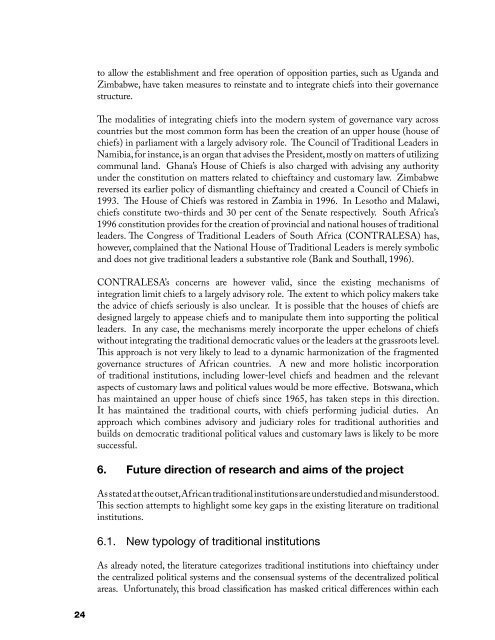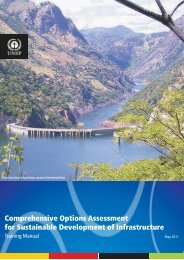Relevance of - United Nations Economic Commission for Africa
Relevance of - United Nations Economic Commission for Africa
Relevance of - United Nations Economic Commission for Africa
You also want an ePaper? Increase the reach of your titles
YUMPU automatically turns print PDFs into web optimized ePapers that Google loves.
to allow the establishment and free operation <strong>of</strong> opposition parties, such as Uganda and<br />
Zimbabwe, have taken measures to reinstate and to integrate chiefs into their governance<br />
structure.<br />
The modalities <strong>of</strong> integrating chiefs into the modern system <strong>of</strong> governance vary across<br />
countries but the most common <strong>for</strong>m has been the creation <strong>of</strong> an upper house (house <strong>of</strong><br />
chiefs) in parliament with a largely advisory role. The Council <strong>of</strong> Traditional Leaders in<br />
Namibia, <strong>for</strong> instance, is an organ that advises the President, mostly on matters <strong>of</strong> utilizing<br />
communal land. Ghana’s House <strong>of</strong> Chiefs is also charged with advising any authority<br />
under the constitution on matters related to chieftaincy and customary law. Zimbabwe<br />
reversed its earlier policy <strong>of</strong> dismantling chieftaincy and created a Council <strong>of</strong> Chiefs in<br />
1993. The House <strong>of</strong> Chiefs was restored in Zambia in 1996. In Lesotho and Malawi,<br />
chiefs constitute two-thirds and 30 per cent <strong>of</strong> the Senate respectively. South <strong>Africa</strong>’s<br />
1996 constitution provides <strong>for</strong> the creation <strong>of</strong> provincial and national houses <strong>of</strong> traditional<br />
leaders. The Congress <strong>of</strong> Traditional Leaders <strong>of</strong> South <strong>Africa</strong> (CONTRALESA) has,<br />
however, complained that the National House <strong>of</strong> Traditional Leaders is merely symbolic<br />
and does not give traditional leaders a substantive role (Bank and Southall, 1996).<br />
CONTRALESA’s concerns are however valid, since the existing mechanisms <strong>of</strong><br />
integration limit chiefs to a largely advisory role. The extent to which policy makers take<br />
the advice <strong>of</strong> chiefs seriously is also unclear. It is possible that the houses <strong>of</strong> chiefs are<br />
designed largely to appease chiefs and to manipulate them into supporting the political<br />
leaders. In any case, the mechanisms merely incorporate the upper echelons <strong>of</strong> chiefs<br />
without integrating the traditional democratic values or the leaders at the grassroots level.<br />
This approach is not very likely to lead to a dynamic harmonization <strong>of</strong> the fragmented<br />
governance structures <strong>of</strong> <strong>Africa</strong>n countries. A new and more holistic incorporation<br />
<strong>of</strong> traditional institutions, including lower-level chiefs and headmen and the relevant<br />
aspects <strong>of</strong> customary laws and political values would be more effective. Botswana, which<br />
has maintained an upper house <strong>of</strong> chiefs since 1965, has taken steps in this direction.<br />
It has maintained the traditional courts, with chiefs per<strong>for</strong>ming judicial duties. An<br />
approach which combines advisory and judiciary roles <strong>for</strong> traditional authorities and<br />
builds on democratic traditional political values and customary laws is likely to be more<br />
successful.<br />
6. Future direction <strong>of</strong> research and aims <strong>of</strong> the project<br />
As stated at the outset, <strong>Africa</strong>n traditional institutions are understudied and misunderstood.<br />
This section attempts to highlight some key gaps in the existing literature on traditional<br />
institutions.<br />
6.1. New typology <strong>of</strong> traditional institutions<br />
As already noted, the literature categorizes traditional institutions into chieftaincy under<br />
the centralized political systems and the consensual systems <strong>of</strong> the decentralized political<br />
areas. Un<strong>for</strong>tunately, this broad classification has masked critical differences within each<br />
24
















